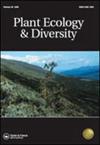印尼婆罗洲古农克兰岛的长尾草生态学
IF 1.6
4区 生物学
Q2 PLANT SCIENCES
引用次数: 8
摘要
摘要背景Clipeeta猪笼草是一种极度濒危的植物物种,其种群仅分布在印度尼西亚加里曼丹的Gunung(Mount)Kelam,正受到威胁——其营养关系尚未得到研究。目的通过评估目前的种群数量和提供有关其矿物营养关系的信息,提高对夹竹桃自然生态的认识。方法在2019年进行了一项调查,记录了北美猪笼草的种群数量和栖息地偏好。分析了土壤、叶片和猪笼草液中的营养成分浓度,并与其他猪笼草物种的营养成分进行了比较。结果在古农克拉姆发现了18个剪叶猪笼草个体(其中只有1个为雌性)。发现了另外七种猪笼草,并观察到了其中两种和猪笼草的杂交种。尽管克利皮塔猪笼草的叶面营养浓度(“onome”)与其他猪笼草物种不同,克利皮塔的营养浓度更高,尤其是氮、钾和钙,但氮限制仍然普遍存在。结论夹竹桃在野外仍然存在,但数量非常少,这表明需要采取保护措施。与其他种类的猪笼草一样,它也受到土壤氮浓度的限制,尽管它有一个来自高叶面营养浓度的独特离子组。本文章由计算机程序翻译,如有差异,请以英文原文为准。
Ecology of Nepenthes clipeata on Gunung Kelam, Indonesian Borneo
ABSTRACT Background Nepenthes clipeata is a Critically Endangered plant species with the population at its only location in the wild, Gunung (Mount) Kelam in Kalimantan, Indonesia, under threat – its nutrient relationships have not been studied. Aims To improve understanding of the autecology of N. clipeata by assessing the current population and providing information on its mineral nutrient relationships. Methods A survey was undertaken in 2019 when population numbers and habitat preferences of N. clipeata were recorded. Nutrient concentrations in soil, leaves and pitcher fluid were analysed and compared with those in other Nepenthes species. Results Eighteen individuals of N. clipeata were found on Gunung Kelam (only one of which was female). Seven other Nepenthes species were found and hybrids with two of these and N. clipeata were observed. Although the foliar nutrient concentrations (‘ionome’) of N. clipeata appeared distinct from that of other Nepenthes species, with N. clipeata having greater nutrient concentrations, particularly nitrogen, potassium and calcium, nitrogen limitation was still prevalent. Conclusions N. clipeata still persists in the wild but with very low numbers, indicating that conservation actions are required. Along with other species of Nepenthes, it is limited by soil nitrogen concentrations although it has a distinct ionome derived from high foliar nutrient concentrations.
求助全文
通过发布文献求助,成功后即可免费获取论文全文。
去求助
来源期刊

Plant Ecology & Diversity
PLANT SCIENCES-
CiteScore
3.30
自引率
0.00%
发文量
26
审稿时长
3 months
期刊介绍:
Plant Ecology and Diversity is an international journal for communicating results and novel ideas in plant science, in print and on-line, six times a year. All areas of plant biology relating to ecology, evolution and diversity are of interest, including those which explicitly deal with today''s highly topical themes, such as biodiversity, conservation and global change. We consider submissions that address fundamental questions which are pertinent to contemporary plant science. Articles concerning extreme environments world-wide are particularly welcome.
Plant Ecology and Diversity considers for publication original research articles, short communications, reviews, and scientific correspondence that explore thought-provoking ideas.
To aid redressing ‘publication bias’ the journal is unique in reporting, in the form of short communications, ‘negative results’ and ‘repeat experiments’ that test ecological theories experimentally, in theoretically flawless and methodologically sound papers. Research reviews and method papers, are also encouraged.
Plant Ecology & Diversity publishes high-quality and topical research that demonstrates solid scholarship. As such, the journal does not publish purely descriptive papers. Submissions are required to focus on research topics that are broad in their scope and thus provide new insights and contribute to theory. The original research should address clear hypotheses that test theory or questions and offer new insights on topics of interest to an international readership.
 求助内容:
求助内容: 应助结果提醒方式:
应助结果提醒方式:


